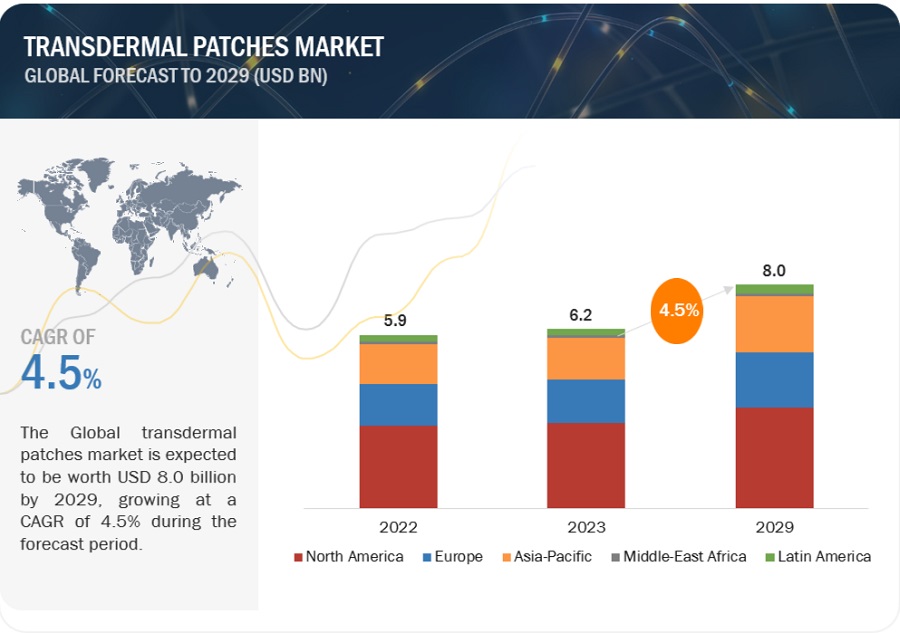The global transdermal patches market has seen significant growth, with revenue estimated at $6.2 billion in 2023 and projected to reach $8.0 billion by 2029. This growth, at a compound annual growth rate (CAGR) of 4.5% from 2023 to 2029, is driven by several factors, including the increasing prevalence of chronic diseases, advancements in patch technology, and a shift from traditional injection methods to transdermal delivery systems.

Key Drivers of Market Growth
Growing Adoption of Analgesic Patches
A major driver of the transdermal patches market is the increasing adoption of analgesic patches. These patches offer a non-invasive, targeted approach to pain management by providing controlled, sustained release of medication directly through the skin. This method not only improves patient comfort but also reduces the risk of systemic side effects associated with oral pain medications. The convenience and prolonged efficacy of analgesic patches make them a preferred option for patients with chronic pain conditions, contributing to their rising demand.
Market Restraints
Drug Failure and Recalls of Transdermal Drug Delivery Systems
Despite the benefits of transdermal patches, the market faces challenges, particularly related to drug failure and product recalls. Issues such as inconsistent drug delivery, formulation problems, adhesive performance, and skin irritation can lead to inadequate therapeutic outcomes or adverse reactions. These challenges underscore the need for stringent quality control during the development and manufacturing of transdermal patches to ensure safety and efficacy.
Opportunities in the Market
Collaborations Between Pharmaceutical and Drug Delivery Companies
Collaborative efforts between pharmaceutical companies and drug delivery firms are creating new opportunities in the transdermal patches market. These partnerships leverage the expertise of pharmaceutical companies in drug formulation and the innovative delivery technologies developed by drug delivery firms. The result is the development of advanced transdermal patches that offer improved drug release profiles, increased patient adherence, and reduced side effects, ultimately enhancing patient outcomes.
Challenges in the Market
Technical Barriers Related to Skin Irritation and Permeability
One of the significant technical challenges in the transdermal patches market is balancing drug permeability through the skin while minimizing irritation. The skin’s natural barrier, the stratum corneum, poses a challenge to effective drug penetration, requiring innovative solutions to enhance permeability without compromising skin integrity. Addressing these challenges is crucial for the continued development of effective and patient-friendly transdermal patches.
Market Segmentation and Regional Insights
Leading Segment: Multi-Layer Drug-In-Adhesive Patches
The multi-layer drug-in-adhesive segment is expected to dominate the transdermal patches market during the forecast period. This segment’s innovative design allows for precise control over drug release rates and the ability to deliver multiple medications simultaneously, catering to complex therapeutic needs.
Fastest Growing Region: Asia Pacific
Asia Pacific is projected to have the highest CAGR in the global transdermal patches market. Factors such as the rising prevalence of chronic diseases, increasing awareness of non-invasive drug delivery methods, and advancements in healthcare infrastructure are driving market growth in this region. Additionally, the region’s large aging population and improving disposable incomes contribute to the growing demand for transdermal patches.
Key Players in the Transdermal Patches Market
Some of the leading companies in the transdermal patches market include Johnson & Johnson (U.S.), Viatris Inc. (U.S.), Hisamatsu Pharmaceuticals Co. Ltd. (Japan), Boehringer Ingelheim International GmbH (Germany), and Teva Pharmaceutical Industries Ltd. (Israel). These companies are at the forefront of innovation and development in the transdermal patches market.
Recent Developments in the Industry
The transdermal patches industry has seen several significant developments, such as acquisitions and collaborations that aim to enhance product offerings and expand market presence. For instance, in July 2023, Industria Macchine Automatiche S.P.A. (Italy) acquired Phoenix Italia S.r.l. and its subsidiary, Phoenix Tech S.r.l., to strengthen its capabilities in transdermal patch production.
Conclusion
The global transdermal patches market is poised for steady growth, driven by the increasing adoption of non-invasive drug delivery methods and technological advancements. However, challenges such as drug failure and technical barriers need to be addressed to sustain this growth. Collaborative efforts between pharmaceutical companies and drug delivery firms will play a crucial role in overcoming these challenges and driving innovation in the market. As the demand for patient-friendly and effective drug delivery systems continues to rise, the transdermal patches market is expected to see significant advancements in the coming years.
